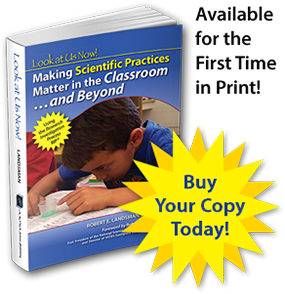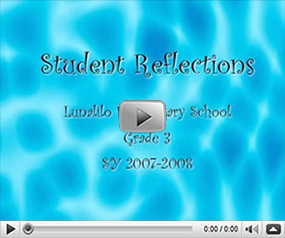ANOVA Science Education Releases K-12 Classroom Scientific Practices Book Written by Teachers and a Research Scientist
“Look at us now!” exclaim teachers who exhibit exemplary inquiry-based instruction in “Making Scientific Practices Matter in the Classroom…and Beyond Using the Research Investigation Process (RIP®).” This book, edited by Dr. Robert E. Landsman, with a Foreword by Dr. Robert E. Yager, is a collection of exemplary applications of scientific practices shared by teachers for teachers. They have transformed themselves and their students using scientific inquiry to bring a balance of rigor, joy, and excitement into the world of learning across content areas.
Pompton Plains, New Jersey—October 15, 2012 – ANOVA Science Education Corporation (ANOVA Science, http://www.scientificinquiry.com) announced today the release of its newest scientific inquiry book for K-12 teachers, "Look At Us Now! Making Scientific Practices Matter in the Classroom...and Beyond." The release of this highly anticipated book is already being met with much excitement from science teachers and educators who have had the opportunity to review it or pick up a copy at the book's unveiling last week at the annual New Jersey Science Convention in Princeton, NJ. Compiled and published by ANOVA Science Publishing, the book is a full invitation into the teaching approaches of thirteen teachers resulting from their participation in ANOVA Science’s professional development training. According to Dr. Robert Landsman, president of ANOVA Science, “The book will serve as a valuable resource for teachers to implement inquiry as a critical thinking tool in any context.”
“This book is for teachers, and by teachers,” Dr. Landsman says. “Teachers, with the dramatic exponential changes occurring in today’s world, society sees you as the difference between student success and failure. So, what do you need in your toolbox to deliver the success, regardless of grade level, academic ability, and content area? Our new book, 'Look at Us Now! Making Scientific Practices Matter in the Classroom…and Beyond Using the Research Investigation Process (RIP®),' is the answer.”
The thirteen classroom-teacher authors describe to their readers how they implemented scientific practices using the Research Investigation Process (RIP®) scientific inquiry model and the outcomes they achieved in their K-12 classrooms. According to RIP designer Dr. Robert Landsman, who contributed three of the chapters in the new book, “This model is successful because students are driven by their desire to find answers to their own questions as they use the thinking and learning processes applied by scientists. This provides them the tools for meeting head-on the challenges they face in learning about and understanding for application the standards-based content that is applicable to their investigation.”
High school teacher Hank Starr from Bloomfield School District in New Mexico commented, “Every teacher should own this book, digest and then embrace its contents, and read it over and over again. This education model has inspired me to move in different directions in my classroom, in my education, and in my personal life.”
In "Look at Us Now!" the classroom teachers and a standards-based resource teacher team up as chapter authors with research scientist and STEM education specialist Dr. Landsman to describe full and open inquiries conducted in the K-12 classroom focusing on science, language arts, mathematics, social studies, and STEM. According to former National Science Teacher Association president and current Director of its Exemplary Science Programs Dr. Robert Yager, “Landsman and the teacher authors illustrate well the power of ‘inquiry’….” Yager, author of the book’s Foreword, states, “Contributions in this book were written by members of the audience it serves: the K-12 classroom teacher. Landsman has chosen his teacher authors for this book brilliantly, and I’m sure from his own experiences as a research scientist, middle and high school teacher, and university professor.”
Each chapter describes the process used and impact of implementing scientific inquiry, the practices used by scientists to learn about the natural world, into the classroom as it is envisioned in the “National Science Education Standards,” the recently released “Framework for K-12 Science Education,” and the soon to be released “Next Generation Science Standards.”
According to Landsman, “Many science education specialists feel that a major reason that we have not made substantial gains in K-12 science since the ‘National Science Education Standards’ were released 16 years ago, is that the schools were unable to implement the district, school and classroom level conditions (referred to in the Standards as 'More Emphasis' conditions) necessary for achievement of the standards.”
Through each chapter, the reader can follow exactly what was being thought by the teacher(s) and the strategies they used to address the "More Emphasis" conditions to meet the national science goals. The U.S. is about to release its “Next Generation Science Standards” (NGSS) and, like its predecessor, the “National Science Education Standards,” its success relies heavily on teachers being able to instruct and students to learn through scientific inquiry.
“The release of ‘Look at Us Now!’ could not have been timelier,” writes Yager. “How scientific practices are mastered is just as important as the mastery of the practices themselves and this is a time of urgency for how the NGSS will be approached at the classroom level. The relevance of the content of this book is very important for the interpretation of how the NGSS will be approached at K-12 classroom levels. As you will discover, the scientific inquiry model presented in the pages of this book provides a tool for learning that can motivate students to learn in all content areas as well as bridge diverse content areas such as the four content areas of STEM.”
RIP is a trademark and service mark, and RIP is the registered trademark and registered service mark, of ANOVA Science Education Corporation, ANOVA Science Publishing, and Dr. Robert Landsman in the U.S. and/or other countries. ANOVA Science Education Corporation assists schools in implementing scientific research-based science education programs, providing students with critical thinking and decision-making tools for life-long learning skills that support economic growth and global competitiveness through high-quality, continuous, and data-driven teacher support in schools and classrooms throughout the U.S. As sole distributor of products and services associated with the Research Investigation Process (RIP®) inquiry-based science education program for K-12 schools, the contribution of ANOVA Science's vision toward the nation's movement for science education reform has been recognized and is well received by national and state education organizations. ANOVA Science's activities and services include professional development workshops, seminars and projects; teacher coaching and mentoring; curriculum development addressing state and national standards; and publishing education materials available online at anovascience.com.
Your Shopping Cart
Ordering five (5) or more copies? Contact us for a special volume discount.
Read the Foreword
Enter your name and e-mail address below for immediate access to read the complete Foreword, written by Dr. Robert E. Yager, in its entirety.


 ANOVA Science
ANOVA Science